November 2007

This month marked the end of our above average fall season, with a grand total of 8,514 birds banded since 1 August. Though behind the excellent (third highest ever) total of 10,022 last year, it is still the 7th highest for a fall in 47 years of banding at Powdermill.
November birds contributed 1,769 to the above total. In fact, this was the second highest November total we have ever had, behind the record number of 2,342 in 1985. Highest daily banding totals for the period were on 11/4 (245), 11/7 (177), 11/16 (160), and 11/6 (141).
High totals this November were a result of late migration and irruption of many boreal species. Reports of good numbers of more northern species like Evening Grosbeak, Pine Siskin, and Red-breasted Nuthatch have been spreading across the region, and Powdermill was no exception.
Along with boosting the overall total, this southward movement, likely due to shortages of important winter food sources in the North, also resulted in some record banding totals at Powdermill for several boreal species: 116 Fox Sparrows (previous high - 95 in 1985), 106 Northern Saw-whet Owls (previous high - 13 in 2005; however, this was our first year with a consistent effort), and 5 Red-breasted Nuthatches (previous high - 3 in 2001).
With an additional 922 banded this month, American Goldfinch, also technically a boreal species, far surpassed the previous high season total of 1654 in 2001. Our final fall 2007 AMGO total was 1835. While not a new record, Purple Finch (432) placed eighth out of 47 in overall fall season totals for this species.
You can read more about the irruption of boreal species this year in this article published by eBird.

Along with our regular volunteers, Mary Shidel, Lauren Schneider, Dean Thompson, Kristin Sesser, and Mike Comley, we had additional help from visiting banders Rosemary Spreha, Guy Ubaghs, and Keith McKenrick (all of which were also past participants in Powdermill Banding Workshops).
Our second week long bander workshop for the fall (a beginner course) was this month and we welcomed four new participants. It was a very fun and fulfilling week for all involved.
In the photo to the left from left to right are (back row) - Bob Mulvihilll, Sandy Teliak (workshop participant), and Bob Leberman; (front row) - "Puppy" Mulvihill, Ryan Trimbath (workshop participant), Daily Leonard (workshop participant), Adrienne Leppold, "Kaylee" Leppold, P.J. Falatek (workshop participant), and Molly McDermott (fall banding assistant).


Quintessential sparrows of the North, Fox Sparrows were among the record setting boreal species this month. Below is #96 for the season, banded on 11/17--it put us one up on the previous high fall total for this species. The final FOSP total for this season, 116, will be hard to beat!
Fox Sparrows are among others in the Emberizid family which often show an A1 (i.e., proximal alula) molt limit. This, however, is usually so subtle that we usually rely on skulling in the fall to age these birds.
There were the occasional birds though, especially with so many caught this fall, that showed this limit (or a carpal covert limit) very clearly. Note in the photo to left that the shaft, in particular, of the smaller A1 feather is darker.

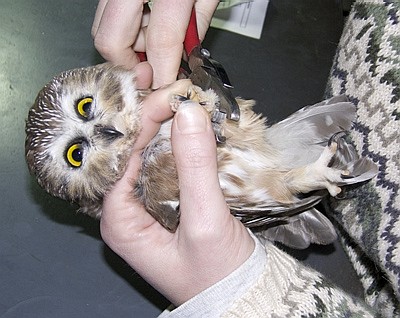
This fall we made a much more concerted effort to contribute to Project Owlnet, a cooperative banding project designed to elucidate the timing and pattern of migration of the small migratory Northern Saw-whet Owl. Modeled after the ambitious "Operation Recovery" cooperative songbird migration study launched in the 1960s,
Project Owlnet has succeeded because it uses a large number of well scattered stations all of which employ audio lures to attract owls into mist nets. Consequently, the rate of exchange of banded owls among Project Owlnet partner sites is fairly high (probably several magnitudes of order higher than ever was enjoyed among the songbird banding stations involved in Operation Recovery).
We began our owl-banding efforts on 13 October and continued through November operating owl nets a total of 17 nights throughout the season (i.e. 2-4 nights a week), averaging about 25 net hours a night.
All but one of the nights resulted in captures of NSWOs (incidentally, the one night we were not successful with saw-whets, we caught our one Eastern Screech Owl for the season). Our highest single night's catch was 18 on 2 November, including one foreign retrap.
As mentioned above, the rate of exchange of banded owls among members of Project Owlnet is fairly high. Two of our owls from this fall were recaptured by banders south of us and we caught two foreign birds.
One, # 0924-14882, was originally banded at Prince Edward Point Bird Observatory in Ontario on 23 October 2005. It was aged as a TY during its original capture, thus making it 4 1/2 years old when we recaptured it this fall. The other, # 0924-14744, was originally banded near Lakefield Ontario on 28 September 2005 as an HY-F, making it now a TY.
Both of our owls that were recaptured showed up in Kevin Dodge's nets at his Casselman River site in Maryland; one was even a same night recovery. We banded # 0924-24335 on 10/28 at 9:50pm and Kevin recaptured it at 6:29am the following morning.
We gave her a fat score of a 1 (on a scale of 0-3) and she weighed 97.3g during her original banding. The following morning at Kevin's site, roughly 60km SSE of PARC, she was devoid of any fat reserves and weighed 88g.
In the photo on bottom, Banding Program Coordinator, Adrienne Leppold, bands one of the 58 owls caught this month.

The HY male Red-breasted Nuthatch pictured to the left brought our fall banding total to five. Not only is this a new season record for us, even one would be a "good get," because the long-term fall average for this species is <1.



Of the 922 American Goldfinches banded this month, three of them expressed abnormal feather pigmentation. While we have documented similar cases before on this website, we admit to always being a bit confused by the correct terminology to use for the wide variety of plumage aberrations we have witnessed (e.g. albinism, partial albinism, leucism, etc.). Coincidentally, a very interesting article (containing several Powdermill pictures) was published in this September
/ October's edition (vol. 39, no. 5) of Birding, the magazine of the
American Birding Association. It addressed the nearly universal confusion over this topic and proposed a new, more precise terminology. We have tried to use the author, Jeff Davis', proposed terminology in describing the birds below.
Two different adult male American Goldfinches banded in November were good examples of partial amelanism. Even in winter, adult male goldfinches can show some black in their forecrown.
Because these birds lacked most or all of the melanin pigments usually present in their head feathers, normally hidden yellow carotenoid pigments were fully revealed. The scattered all-white wing feathers in the top bird also are a common result of partial amelanism.
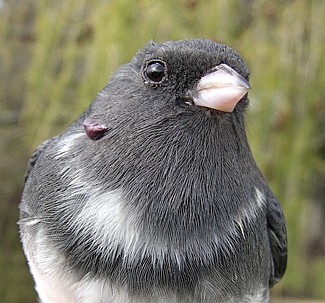
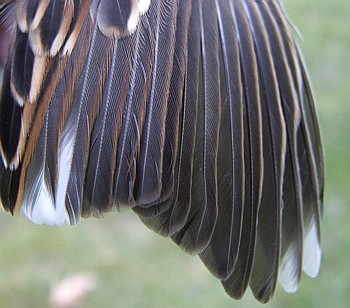
One or two incidences of abnormal coloration are normal for us to see during a season at Powdermill. In addition to the goldfinches above, we also caught a Dark-eyed Junco and White-throated Sparrow this month that expressed partial amelanism.
The "white-collared" junco (Pictured on Top) also happened to have an engorged tick on the right side of its throat. The partial amelanism in the White-throat was restricted to the tips of some of its flight feathers and a few scattered white back feathers.
As Jeff Davis points out in his Birding article, "Documenting the distribution, effects, and frequency of color abnormalities could also have conservation implications if any of these conditions arise from exposure to environmental contaminants."
The effects of color abnormalities on a bird can vary. Of the above cases, the goldfinch is likely more at risk for predation because its abnormal pigmentation makes it much more conspicuous (within a flock of normally colored goldfinches) to predators. Unlike a bird with total amelanism, the above birds all still have melanin pigments in their eyes, so they do not suffer from impaired vision.


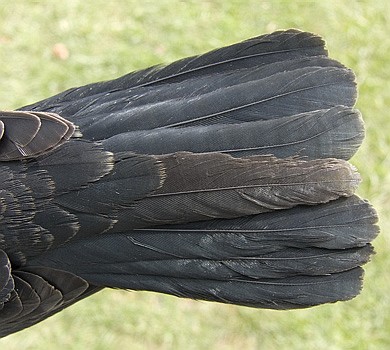
While we're on the subject of pigments, Jeff Davis' interesting Birding article also tells us that the pigment pterin is responsible for the yellowish eye color of the Rusty Blackbird pictured at top (and of yellow, orange, and red irises in many other species; for four more examples, scroll halfway down our October Highlights page).
Neither the overall difference in plumage appearance nor the similarity in eye color compared to the bird above can be used to reliably age the male RUBL pictured in middle.
Immature blackbirds frequently undergo a complete first prebasic molt. If any juvenal feathers are retained, it usually is among the underwing coverts and only very rarely among the flight feathers. This HY male RUBL had retained one of its juvenal central rectrices in addition to some underwing coverts.


11/02 was a red-letter day! Two Evening Grosbeaks were the first ones banded at Powdermill since 2001, and the very first of their kind ever handled by this Powdermill Bander-in-Charge.
Both were adult (AHY) females. You have to search back >20 years to find Powdermill's record high November banding total for EVGR--421 in November 1985!
Up to a half dozen EVGRs at a time were seen in the banding area over the next month or so, but, unfortunately, no others were caught. On the bright side, we still have all of our fingers (they don't call them "gros" beaks for nothing)!


We banded a good total of five Yellow-bellied Sapsuckers in November, including the HY male (top bird) and HY female (bottom bird) pictured below.
Both have a red forecrown and scattered brown juvenal head feathers. It is the red throat that distinguishes the male (the female's throat is whitish).

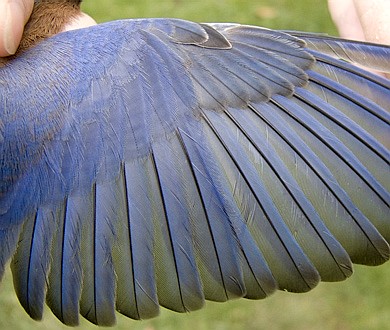

We banded three Eastern Bluebirds on 11/17, our first for the fall season. First was a brilliant blue adult (AHY) male (top photo); second was an HY male (wing photo) with its considerably duller blue flight feathers and coverts (and showing molt limits between its retained juvenal carpal covert and molted greater coverts, and between molted
A1 and retained juvenal middle and distal alula feathers); the third, an HY female (bottom photo) naturally had the most dull colored wing feathers of the three.


We have mentioned before about our involvement with the Hummer Bird Study Group, a cooperative banding project spearheaded in Alabama by Bob and Martha Sargent and aimed at elucidating the patterns and timing of migration of up to a dozen western Hummingbird species now known to sometimes migrate through and winter in the eastern U.S. As cooperators with this project, we are always "on alert" and "on call" to investigate late lingering hummingbirds coming to feeders anywhere in western Pennsylvania and surrounding areas (colleagues of ours cover the middle and eastern parts of the state). By far, the most commonly encountered western species in the East is the Rufous Hummingbird.
We answered the call to investigate two late hummers still coming to feeders in November. Truthfully, we had tried but failed to catch one of these (a suspiciously very wary and wily bird coming to Ray and Eydie Posel's feeder in McDonald, PA, in mid-October) on our first try, but we succeeded on November 2 in trapping the bird at a feeder belonging to the Posel's nextdoor neighbor, Kim Sartori (pictured below with Adrienne Leppold just before releasing the bird).
The story of this bird actually begins last November, when we trapped it at the Posels only to discover that it was already wearing band no. N-71927. We shortly learned it had been banded the winter before in Diamondhead, Mississippi. The Posels last saw it on 12/19/06, when it presumably continued on its southward migration toward its wintering grounds (Diamondhead, MS again?). Doubtless it migrated back to its Rocky Mountain nesting grounds this past spring, afterwards migrating southeast once again and finding its way to a migratory stopover site at the very same house and feeder in southwestern Pennsylvania!
Amazing as this story of survival and navigation may seem, it's nothing compared to the saga that our good friend Bill Hilton tells of a Rufous Hummingbird that returned this year to the same South Carolina home and feeder to spend its fifth consecutive winter! (click here to read the whole story, illustrated with Bill's always excellent photos).
Pictured on Top and Bottom Close up of returning adult female Rufous Hummingbird no. N-71927.

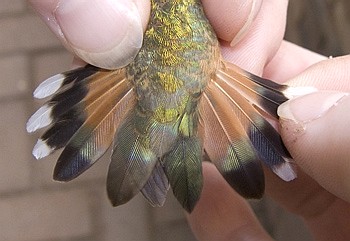
We caught and banded a second Rufous Hummingbird on 11/21 at Patti Briggs' house in Burgettstown, PA (interestingly, just 10 miles or so west of McDonald, PA, where we recaptured N-71927 on 11/2--makes us wonder just how many of these birds sneak through on migration unobserved!).
Pictured at top to the left are Patti, her daughter Kate, and Adrienne Leppold with the second RUHU, an HY female banded with E-49783. Designed by Bob Sargent, the special wire cage trap that we use for our targeted hummingbird banding (with a hummingbird feeder suspended inside it as bait) is visible in the background.
Bottom Picture is a Spread tail of the HY-F RUHU banded in Burgettstown on 11/21.
